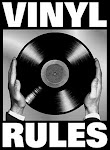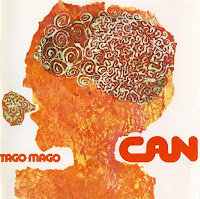Before things get too serious here at Rock On Vinyl, I thought it might be fun to post a song / album at the end of each month, that could be categorized as being either Weird, Obscure, Crazy or just plain Korny.
"The Rebel" is without a doubt one of the most sought-after Black Sabbath songs ever recorded. Although a small fragment of this very un-Sabbath like song can be heard on 'The Black Sabbath Story Volume 1' video, most fans have never heard this still-unreleased 1969 demo, until now."Is it an Earth or Black Sabbath demo? One of the most frequently asked questions about "The Rebel" is whether the song could be considered as an Earth demo. Although the actual acetate credits the recording to Black Sabbath, the song was recorded during a transitional period. It has been alleged in several recent Black Sabbath biographies that the band decided upon changing their name from Earth to Black Sabbath while they were on route to The Star Club in Hamburg in early August 1969. To avoid the inevitable confusion arising from this sudden change, the band performed many prior bookings as Earth. In fact, their final gig as Earth was performed in Kilcaldy, Scotland just one day after recording "The Rebel".
%20-%201968.jpg) |
| Earth (Pre-Sabbath) 1968 |
"The recording session for "The Rebel" took place at Trident Studios in St. Anne’s Court in Soho, which was an 8-track facility at the time. Overseeing the session was Gus Dudgeon, who had also worked with the band Locomotive and would later produce albums for Elton John and David Bowie. The band was less than impressed with Gus, who kept using Locomotive as the benchmark for anything they did. It was than that engineer Rodger Bain was offered his first chance to produce a record…and of course the rest is history.
"The band had just returned from a German tour to begin rehearsing. Manager Jim Simpson suggested that they record "The Rebel", a song that was written by Norman Haines. Norman played keyboards in Jim's band Locomotive. Haines also took part in this session, playing organ and piano. Two months later, the band recorded yet another Haines composition called "When I Come Down", which was retitled "When I Came Down" for the Sabbath version. The band weren't pleased with either of these songs, but went along with the sessions so their manager would have something to shop to the record labels. Neither song represented the heavy rock direction they were already formulating or their Earth-y blues based roots."
So, The Rebel itself provides yet another long missing puzzle piece to the early history of Black Sabbath. “The Rebel” has remained shrouded in mystery simply because due to Sabbath’s reluctance to a share a moment in time that wasn’t up to their usual standards. For them, it was simply an experiment, as well as an opportunity to record the band. Yet the band wasn’t above playing ballads or experimenting on later records (“It’s Alright” or “Changes”, for instance), so “The Rebel” isn’t necessarily that much of a departure within that context. It just didn’t impart the sort of direction or image the band desired for the launch of their recording career. [Review by Rob Dwyer, 25/11/2006]
"The band had just returned from a German tour to begin rehearsing. Manager Jim Simpson suggested that they record "The Rebel", a song that was written by Norman Haines. Norman played keyboards in Jim's band Locomotive. Haines also took part in this session, playing organ and piano. Two months later, the band recorded yet another Haines composition called "When I Come Down", which was retitled "When I Came Down" for the Sabbath version. The band weren't pleased with either of these songs, but went along with the sessions so their manager would have something to shop to the record labels. Neither song represented the heavy rock direction they were already formulating or their Earth-y blues based roots."
%20-%201969%20-%20Left%20to%20right;%20Bill%20Ward%20(drums),%20Tony%20Iommi%20(guitar),%20Ozzy%20Osbourne%20(vocals),%20Geezer%20Butler%20(bass).jpg) |
| Early Sabbath - 1969 |
Ozzy's voice is interesting on these tracks. His enunciation is pretty poor but there's still that certain plaintive, emotional Ozzy thing encoded into the vocals.
Tony & Geezer are much more subdued than usual on “The Rebel”, where they seem to be laying back and playing more of a supporting role. On later recordings, their volume went UP and usually often dominated the proceedings – but not here. Bill Ward isn’t quite as content to melt into the tapestry, adding some additional percussion during the bridge sections. In addition, Norman Haines provides the piano introduction and additional playing throughout the song. He isn’t very loud in the mix on the earlier takes, but does get turned up as the sessions progressed.
When I Came Down" is actually a pretty good song - if they'd recorded it better it could have easily slotted in well on their first album.
Note: There are no COMPLETE versions of the Demo "When I came down" and the 2min version included here is actually a loop that has been spliced together by a fan at some stage. Listen closely. There are only :53 seconds of actual recorded "When I Came Down" material, the rest is just repetition with fade.
I also read somewhere that "Early one morning blues" is in fact a cover of Elmore James' song "Early One Morning" with slightly changed/butchered lyrics. The band playing it on this recording is Sabbath, but it isn't a demo. In fact, it was taped by Alex Wilson on their now-famous concert in Dumfries, Scotland, UK, on November 16th, 1969.
So folks, this month's W.O.C.K on Vinyl post certainly ticks the Obscure box, and what makes it even rarer is that the enclosed files are in lossless format. So grab em' now, before the Osbournes try to take them down.
Earth (Pre - Black Sabbath)
01 The Rebel *
02 When I Came Down
03 Early One Morning
04 Blue Suede Shoes (Black Sabbath soundcheck
on 5/25/70 at Radio Bremen Studios)
Earth were:
Ozzy Osbourne - vocals
Tony Iommi - guitar
Geezer Butler - bass
Bill Ward - dfrums
Norman Haines – keyboards *
Earth (Pre-Sabbath) Link (70Mb)



































































